Into the Desert
By Rebecca A. Eckland
Professional writer and crew for Team Black Angus Cow, 2014 Silver State 508
It’s 7:30 am on the 5th of October. The morning’s crisp and I stand beside the starting line of the inaugural Silver State 508—an ultra endurance cycling race—at the Atlantis Casino in Reno to watch the riders depart. An hour before, nearly 40 solo riders began their journey into the desert—from Reno to Eureka and back again. And now, I watch “Rider A”, Scott Kollins, of team “Black Angus Cow” (a two-man relay team for which I am a crew member) begin.
As the pale dawn turns to day, I have two questions: what will it take for these athletes to ride 508 miles? What will they see out there in the valleys, the vistas, the mountains, the day, the night, the desert?
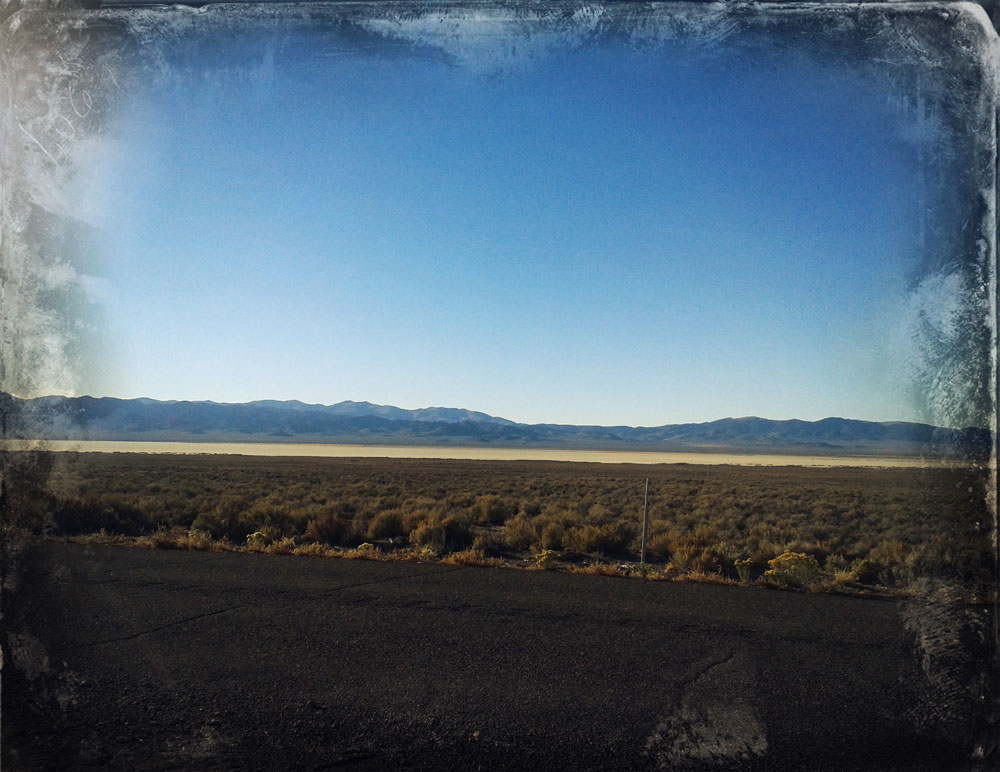
The ride route along NV Highway 50 which is named "the loneliest highway."
*
I have these questions because I’m an athlete and a writer.
I decided to crew for a two-man team from North Carolina I’d never met before for several reasons. The least important: I was still in a “funk” because I had been planning on competing in the Lake Tahoe Ironman which was cancelled a minute before the start due to bad air conditions from a nearby wildfire. It was a race I’d trained hard for and that held an important symbolic meaning for me as an athlete... and a writer.
Yet, the most important reason for participating in the 508, however, was this: it’s rare I’m not the one competing. Instead, I would watch other people do it and I hope to avoid what author David Foster Wallace called “the paradox of the gifted athlete,”that while you compete, you can’t articulate the experience fully. Wallace isn’t talking about a “dumb jock” mentality, but instead, he is qualifying the an athlete’s incredible capacity to focus on the task at hand and nothing else. Or, more precisely, their incredible ability to inhabit the inarticulate realm of the body (of motion, action and reaction) rather than the realm of deep reflection. To have the ability to focus in such a way is the simultaneous gift and curse, he says, of extraordinary athletes.
So, this once, I’ll have the spectator’s chair, watching a race unfold with the luxury of thoughts like: What? Why? (Thoughts that are deeper than the athlete’s challenge of the daunting how?)
*
There is a mystique surrounding ultra-endurance events which is, perhaps, their draw. Unlike a 100 meter swim race, a 5k run or even a triathlon (events which are measured in seconds, minutes and hours), the world or ultra-endurance events is measured in days. The goal is, often, not only aligned with distance and time but also of survival.
Although events like the Silver State 508 are relatively new (or, modern) the impetus behind their existence is not. Whether competing as a solo rider or as a relay team—the effort is routed in our cultural understanding of what it means to complete a journey.
*
The race begins.
Black Angus Cow rider Scott cycles through the streets of South Reno en route to Geiger Grade. The soil is tinged red from iron ore deposits unearthed in the search for gold and the old-growth forest which once covered the Tahoe Basin is now holding the empty caverns of the abandoned mines below our tires.
As a crew member, I won’t see Scott for these first thirty miles of the race. Instead, the rest of team Black Angus Cow (“Rider B”—Keith Weitz, crew member Nicolai and I) drive ahead of him, up Geiger Grade, through Virginia City and down Six Mile Canyon where the leaves of the cottonwood trees are just beginning to turn golden.
We wait for Scott where Six-Mile Canyon meets Highway 50. While we wait, a small church prepares its morning services. The wooden pews, for now, are empty and I’m reminded of the relationship between the outer world and inner world. The church is, after all, nothing but a building. But to its congregation which will arrive an hour later, it will be a spiritual and sacred place.
Equally, the desert is a spiritual and sacred place. What might have appeared ordinary from the seat of a car becomes something else entirely when you experience it from the saddle of a bike for well over thirty hours.
*
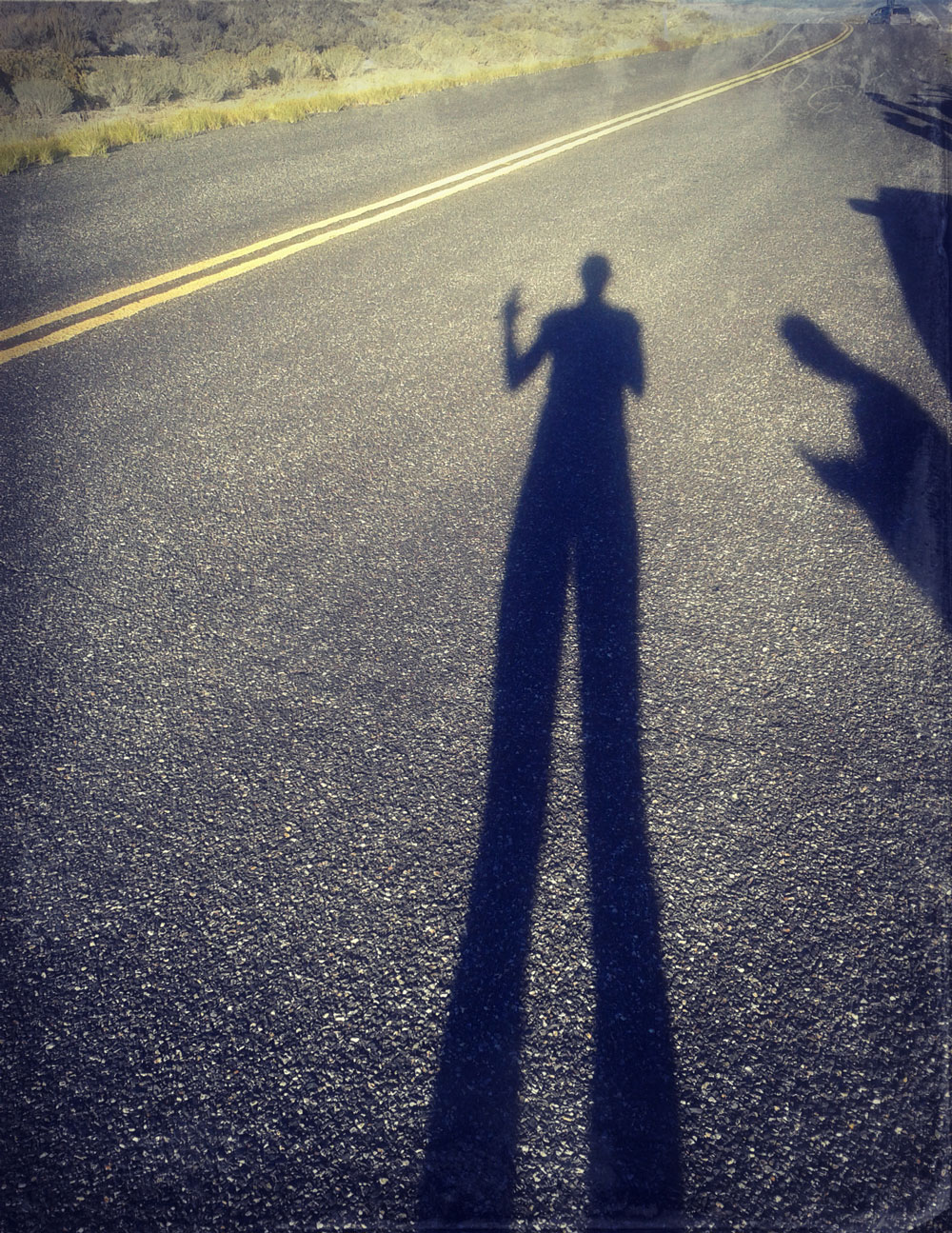
Imprints—and shadows—on the pavement. This is an image I would come to know crewing for Black Angus Cow, a 2-man relay team in the Silver State 508.
You can’t tell me there isn’t something slightly spiritual about an event which requires its participants to come up with a totem—a being or symbol which stands as an emblem for not only the athlete(s), but also the team which supports them. Totems were integral parts to several primitive cultures and scholar Claude Levi-Strauss theorized that totems were used both as identifiers (tying a people to a specific geographical region) but also as a way of turning the complexity of the physical world into a comprehensible, and classifiable, place.
Scott and Keith chose their totem, Black Angus Cow. because of a mutual love of beef brisket and a local BBQ joint in North Carolina (home) where, Keith told me, “we plot our next ridiculous adventure.” Here the animal is less important than what it represents: a sense of camaraderie and shared goals. Or, more precisely, the desire to complete what seems unfathomable—and out of the ordinary—together.
*
World renowned cyclist Tyler Hamilton once said that “You can’t escape the pain. You have to embrace it,”and as the distance of the 508 continues to grow, I begin to wonder about the lines which connect the self to the world, the distance to discomfort. The journey is not only measured in miles, but also in what it takes to push through them.
The discomfort Scott and Keith face is myriad: Scott arrives in Silver Springs where Keith takes over the business of riding. Keith rides a mostly flat and short leg from Silver Spring to Fallon granting Scott less than an hour of rest before his longest leg (106 miles).
The temperature has risen from the morning crisp and both riders have discovered Nevada’s particular challenges: not only is it hot and incredibly dry here, it’s also a higher elevation than the riders are accustomed to.
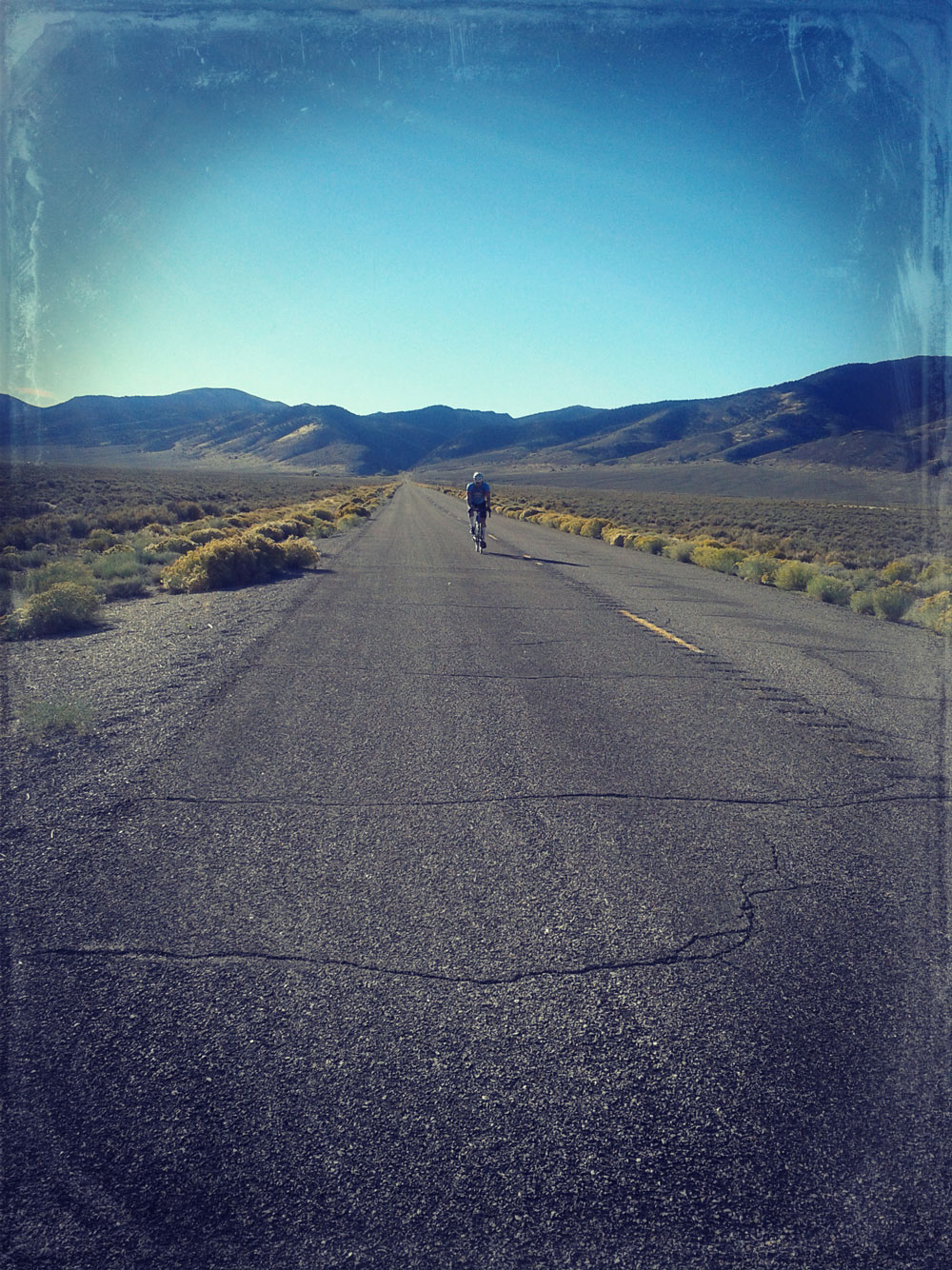
"Rider A" Scott Kollins of team Black Angus Cow on the Silver State 508 course somewhere between Fallon and Austin.
At Stage three (when Scott rides from Fallon to Austin) the landscape opens and becomes vast. The dry alkaline lake bed adjacent to highway 50 is nearly white and the mountains fade blue in the distance. Thick rumble strips cover the shoulder of highway 50 and vehicles speed past riders at 70 mph.
Forty miles into his leg, Scott begins to ascend Carroll Summit. It’s a winding canyon of pinion pines, of low brush and wide blue skies beneath a very hot sun. We stop the van every few miles to fill his emptying water bottles, to offer electrolyte drink and snacks. As he nears the summit, however, his sweat dries in white trails across his black cycling shorts, visual evidence of salt loss. His legs begin to cramp.
As a crew member I do what I can (offering food, water, anything) for Scott as he pedals toward the summit. I put the van in drive as the ascent continues, and I know there’s not much else to do but to let Scott push through his discomfort, a feeling that will come for riders at more than one point during this race.
There is one final climb before Scott’s stage ends; Keith, Nicolai and I wait three miles outside of Austin for him to ride by. It’s dusk and the light is low and we have traveled nearly 185 miles. We face into the fading light and the highway stretches as dotted lights until it disappears into its vanishing point. We try to discern Scott’s bike light from the other lights of cars, from the other lights of riders, and every light that twinkles in the distance.
For now, they are undistinguishable; a strand of souls who, for whatever reason, are traveling east in the low light.
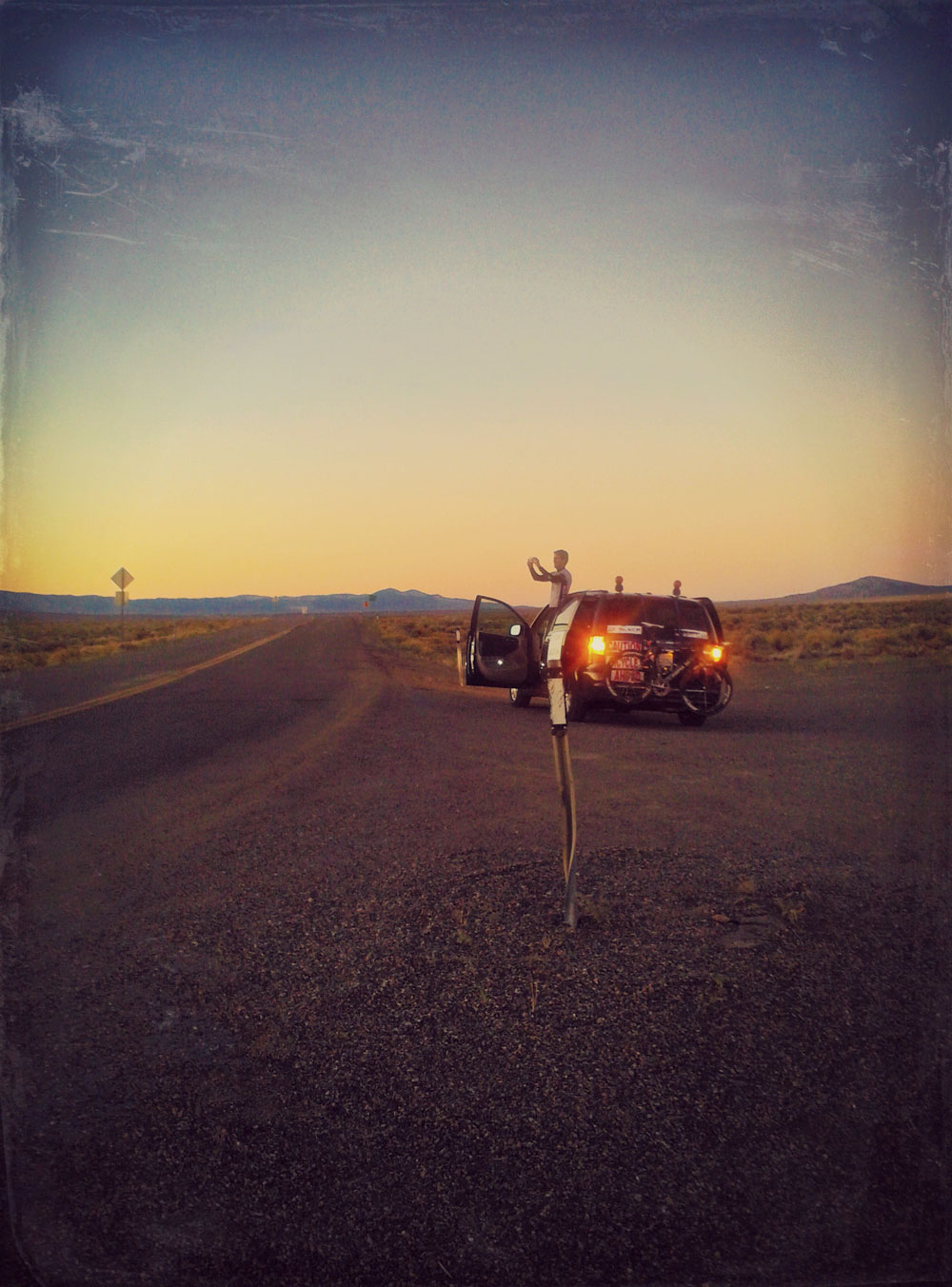
"Rider B" Keith Weitz photographing the sunset as teammate Scott Kollins rides out there, somewhere.
*
We arrive in Austin—a town perched on the side of a hill—in darkness. Keith departs on his bike quickly, asking for us to bring him a jacket before the big descent from Bob Scott Summit. Nicolai and I buy coffee from the gas station which served as our transition area before we decide that Scott—who had just finished his long leg—needs food in the worst way.
Yet, in the darkness of Austin is where the strangeness begins, where the reality of the distance becomes a tough adversary.
One challenge presents itself immediately: hardly anything is open this late at night and the International Café is the first business with lights on that we see, a combination bar and diner with an uneven wooden planked porch.
We’re greeted by a hostess (who looks like she’s had her fill of cyclists and their crew) who says that the kitchen is closed. At first, I don’t quite understand and glance at the other few bodies seated at the wooden tables, wondering why they would sit in a restaurant which didn’t serve food. But then, seeing the look on my face, she clarifies: The kitchen can do three things: a bowl of chili with cornbread, a steak salad or a pizza.
I don’t try to imagine what she means by “steak salad” and, anyway, Nicolai responds in record speed: We’ll order a pizza.
But I can only do two at a time. And there’s a thirty minute wait, she says, gesturing to the other tables filled with diners.
I think of Keith in the cold darkness headed into the dark between Austin and Eureka and about how fast the temperature dropped once the sun set. Thirty minutes sounds incredibly, ridiculously, long.
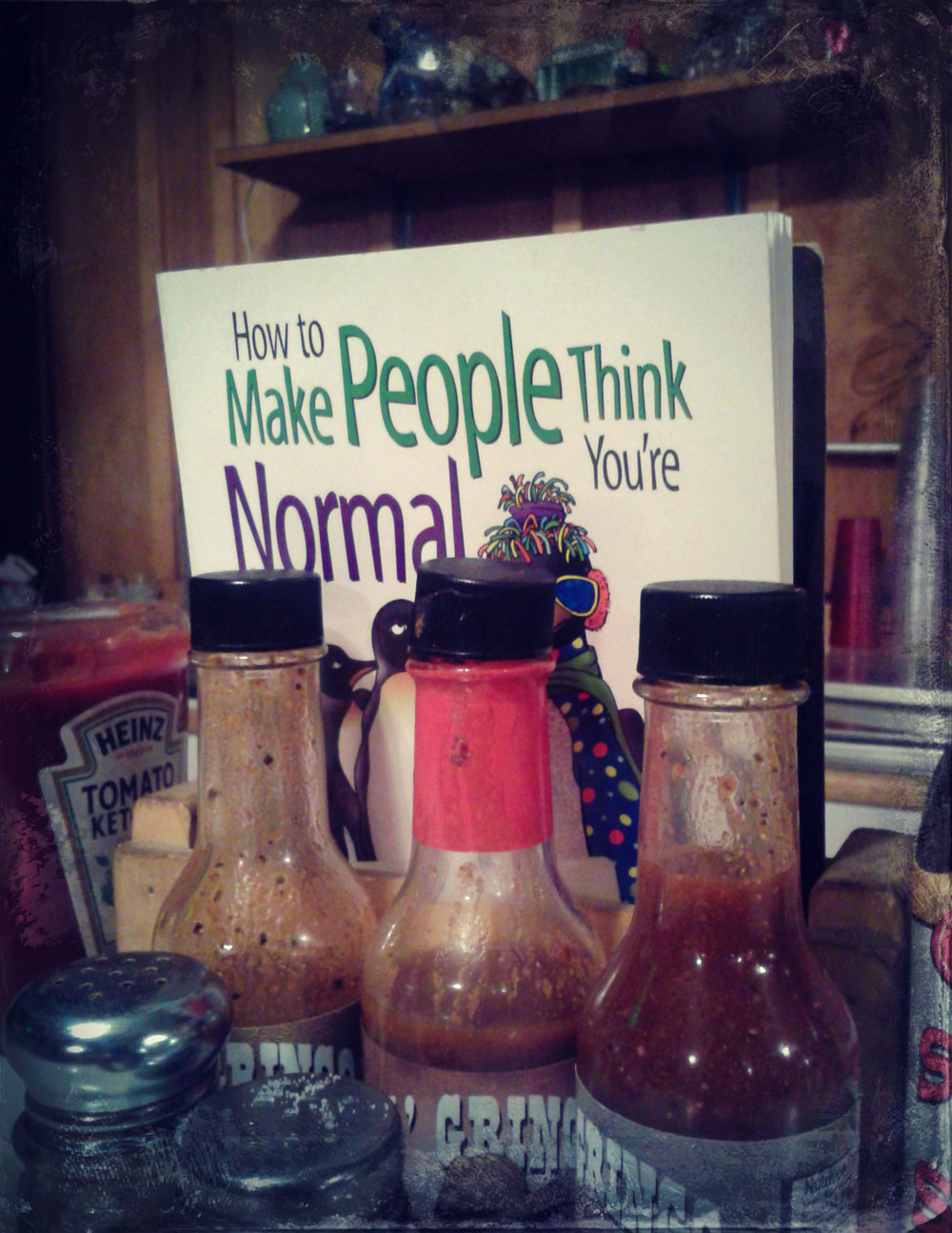
Here is some of the strangeness we find in Austin.
Nothing here seems "normal" after so many hours on the road.
Then I think of Scott who’d ridden 106 miles, the last few of them up the incline to Austin, Scott who wasn’t feeling so great and who needed something warm in his stomach. I leave Nicolai to make the final decision about food because I worry my anxiety would cause me to make the wrong choice (to leave without food in search of Keith in the darkness.)
Instead, I mount the narrow stairs and cross through the old bar to the restroom where the bottom of the mirror is about five and a half feet off the floor and so I can’t even see the expression of my own face without jumping (which I do. And I look worried.)
As I leave the restroom, I see that Scott’s left the van for the first time since his 106 mile leg in the race. His expression says “I’m confused” and he asks me why we are waiting so long. We have to go find Keith, he says.
I nod and tell him that we’re getting pizza; I lie and say it will be done in a few minutes. Scott nods and his eyes rove the bar (missing the narrow hallway to the restaurant) as if asking what kind of pizza would come out of this place. Without a word, he wanders back to the van and I find Nicolai seated in the restaurant, waiting.
I don’t know how long the pizza actually takes, but it had to have been much longer than thirty minutes. A table of young people—three climbers en route to Moab—question another person crewing for a solo rider who was so sick he’d checked into the motel across the street. The crewman was a Race Across America (or, RAAM) veteran and told stories of falling asleep while riding his bike, of hallucination, of fantastic distances, of taping his head so that when he did fall asleep he would still be looking forward.
I listen, half-heartedly, as I worry. I worry this is not what I am supposed to be doing (listening to stories of RAAM or waiting for a pizza), that I have really messed up on my first ultra-endurance event (even as a crew member), that Scott will be mad at me and Keith (riding in the pitch black) will be frozen by the time we get back on the road and catch up to him. After all, he’d made a point to show me where his jacket and warm gloves were kept—in a black sack between the driver and passenger seat—and had therefore entrusted me not to forget.
I tell Nicolai I’m worried and he says something along the lines of relax and I try, I really do, but can’t. Keith doesn’t mind—he’ll tell us this afterward—that the darkness, the silence was something like being dangled out in the vastness of outer space. The darkness: a terrible, wonderful wonder... sublime, perhaps.
*
When the hostess calls out our order, carrying a box which I hope is really filled with this mythic pizza, I jump to retrieve it so that we can sprint back to the van, back out on the road to find Keith. Another group of cyclists who’d arrived ten minutes earlier (and who were enjoying their beers) stand as if to claim what we’d been waiting for.
Nicolai laughs, later, at my ferocity.
I would have karate-chopped them, I’ll say if they’d taken that pizza. Nicolai takes the wheel for the next leg of the race, speeding gas-pedal-to-the-floor-style down the highway in search of our rider, Keith.
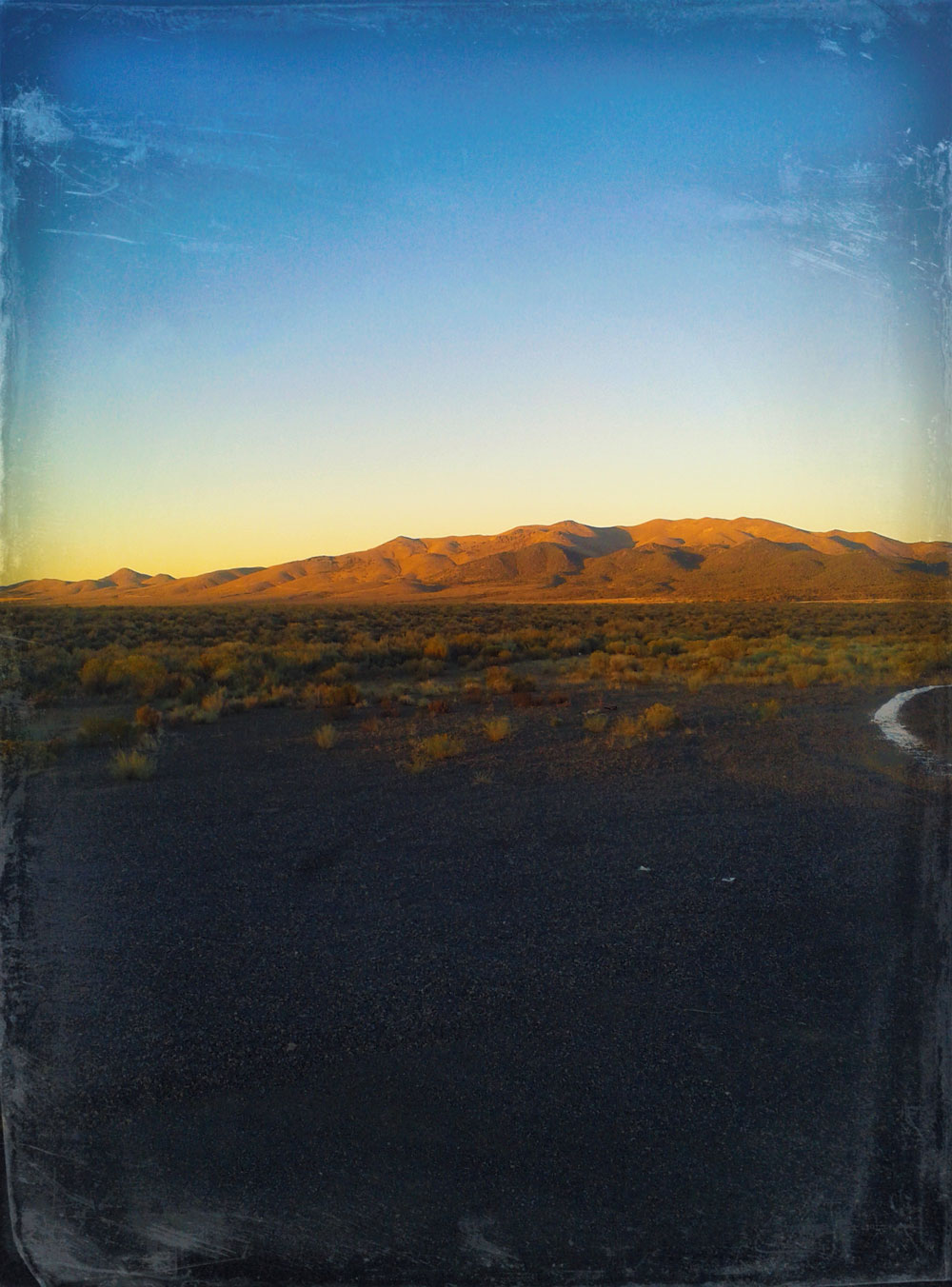
Another shot along the long route of the Silver State 508.
We find him at Bob Scott Summit—just in time—and I jump from the warm van that smells like pizza into the cold night and hand him his jacket before the long descent. I shiver at the coldness in the air. Scott is asleep in the back of the van. We catch Keith again near the bottom where we offer him a slice of (now) lukewarm pizza and a Coke.
I smile slightly to myself when I realize why he’s called The Metronome. That’s exactly his riding style: steady and smooth, never wavering. That’s how he rides all the way to Eureka.
*
We arrive in Eureka. It is late enough that there are hardly any lights on in town at all and structures fade, indiscernible, into the night. When I step outside the van, only my breath is visible and the dark sky filled with stars.
By now we’ve been on the road for over fifteen hours. It’s cold out and Scott is about to begin the ride back east to Austin as soon as Keith arrives. As we wait, I’m given a mission: to find hot water so the riders can have coffee and chicken bouillon to warm them. I ask myself: Where would I find hot water?
The appeal of a red neon sign cuts through the absolute darkness. Of course: the bar. So, dressed in two layers of running tights, a green puffy jacket over which I’ve stretched a reflective vest, I push open the wooden door and am confronted by a grey, unshaven man on a bar stool. If you’re looking for action, honey, you won’t find it dressed like that.
I’m too focused to laugh at how I must look. The man sways, just slightly, in his seat and I walk past him to the other end of the bar.
Can you fill this thermos with hot water? I ask the lady bartender. The air is filled with smoke which drips from the wooden rafters and patrons which have, I sense, been there for quite a while.
Once the thermos is filled, I dash to the van. Scott is ready to begin his ride back into the desert-dark and Keith’s bike is already on the rack on the back of the support van.
For the way back in the darkness, the van has to follow our rider; leap-frogging is over until dawn. This will prove to be my biggest challenge: staying awake.
I play with the satellite radio to stay awake. We listen to ‘80s pop. Contemporary rock. A station called “Classic Vinyl.” I push buttons, hearing nothing but the echo of my one resounding thought: stay awake. But when Scott stops to return to the van for a cup of coffee to warm himself and Nicolai leaves the passenger seat to water the desert shrubs, I sneak into his seat and immediately fall asleep.
*
I dream so vividly I think it’s real. Of the creaking sound of a wooden ship. Of wind and tides. And then I hear the mumble of voices. My name. I wonder: Is it my turn to drive already?
I hear a familiar voice: Rich Staley—my cycling coach and owner of Great Basin Bicycles—who is riding the course solo. He boards the ship, he says “hello.” I wonder if I am dreaming or if I am awake. But somehow the ship fades and I am looking out the driver’s side window and there’s Rich, out there in the darkness.
I’m disoriented, and as he tries to tell me about his race so far, I can’t catch, quite, what he’s saying to me. He tells me it’s been difficult for him to remain awake. I respond with something ridiculous, something like: I’ve listened to over fourteen hours of ‘80s hits!
The familiarity of his voice and face wakes me, though, even as I watch him ride in front of our support van, out past Scott who is still struggling out there in the darkness until even the flash of his red light fades back into the monotone blackness.
We stop again—Scott is frozen—and I use the opportunity to do the one skill I’ve mastered: I pee in the desert, illuminated by stars and moon, the constellation Orion posed directly above me.
*
I wake up in Austin to find that Scott’s done the improbable and pushed through pain and fatigue to get to the transition area. He’s frozen and spent.
I clean out the van, the cold air waking me immediately. Once again, I get hot water. Coffee. Nicolai and I answer Scott’s requests before he once again falls asleep and we are back on the road.
It is all darkness and I paint myself onto the desert. My inconsistencies. My failures. My life which hasn’t turned out the way I imagined it would. My unpublished book. The race I didn’t get to race. My lost shot at the 70.3 World Championships in 2015. The darkness and the cold sucks all the sadness to the surface and I can only imagine what demons Keith and Scott must have encountered out there in the coldness before the dawn.
But then I wonder: maybe it isn’t always the darkness which the desert reveals. Maybe they are thinking of their kids or of taking on a new challenge and the thrill that a new distance, a new event, presents. But for me the darkness opens itself to the questions of “what if?”
The silence of the support van speaks to our own private depths, or, heights.
*
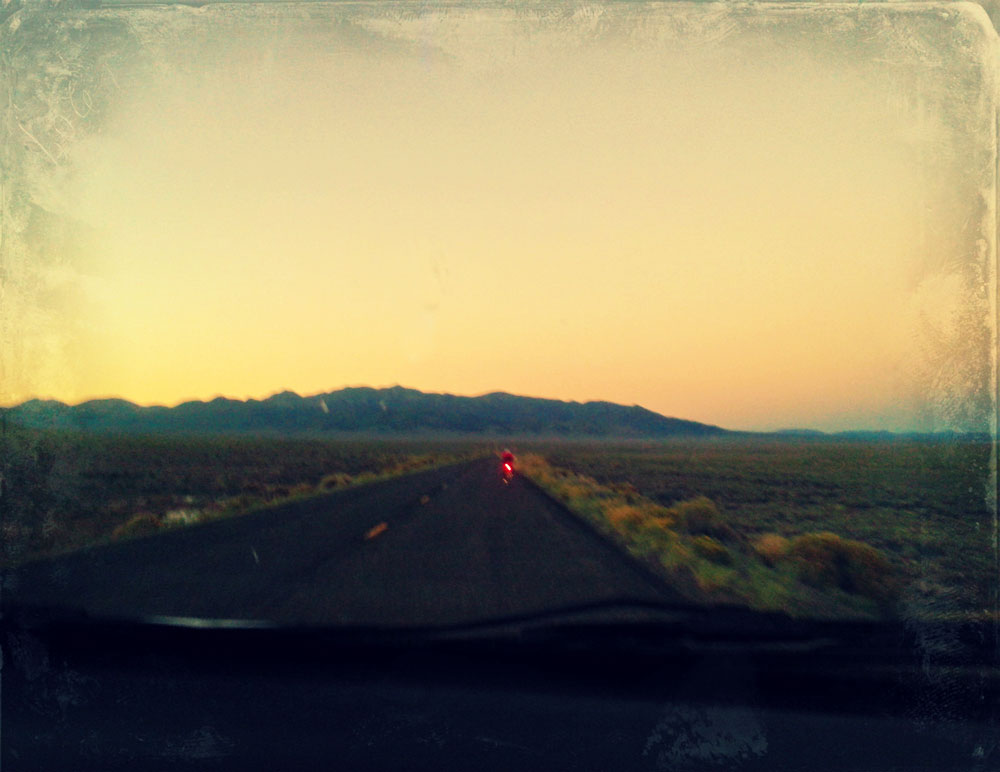
Following "Rider B" Keith Weitz as the light slowly grows across the desert.
The narrow glimmer of a rosy pink on the uneven sunrise immediately opens my eyes. I make a peanut butter bagel for Nicolai who is still driving. Keith is out, riding. Scott is laying down in the back of the van.
I somehow manage to get peanut butter everywhere: all over the van. All over my pants and arms and face. All over Nicolai. When Keith motions for us to stop in 5-10 minutes since we could also remove his lights (the sun nears the horizon now,) and we make him breakfast (oatmeal and coffee.) When he resumes riding, he once again becomes the human metronome; but then he stands out of the saddle—an unexpected motion—since he is still riding on relatively level ground.
From the back of the van, Scott says: Oh, no. He’s got a mechanical issue. Keith pulls to the side of the road and the brief sense of joy (prompted by the return of the sun) has been erased.
*
Keith’s seat had snapped from the rough, uneven roads.
When Nicolai and I inspect the bad news, we see that it’s broken beyond repair. We stare far longer than we should, but the seatless bike hangs from the rack as if it’s taunting us—double-dog-daring us—to come up with a viable solution. I suggest duct tape (doesn’t that fix everything?) but Nicolai shakes his head in a way that makes me realize how ridiculous my suggestion was.
What are we going to do? I ask and I try to think of a way to break the news to Keith and Scott-- our fearless riders-- that neither Nicolai nor I have a solution. I can only imagine what Keith must be thinking. After all, he still has about 140 miles to ride in this race. Now his only option, if he were to ride his own bike, would be to stand up for that entire distance, (which is about as ridiculous as duct taping the seat back onto the broken post.)
*
The solution is ridiculously simple, so much so it reminds me of Julie Moss’s solution to her sudden loss of bodily control hundreds of feet from the finish line of the 1982 Ironman World Championship. Unable to stand any longer, to say nothing of running, Moss found a way to the finish line: she crawled. So too,we find a way: Keith will ride Scott’s bike wearing Scott’s shoes.
Although Scott had texted the race director asking him to put out the word that we needed a new seat post, we adjust Scott’s seat post as much as we’re able and we’re off, riding again. Keith doesn’t fit quite right on Scott’s bike so his rhythm is less steady than on his own bike, but he has a rhythm nonetheless, one that carries him up and over Carroll Summit and across valleys which seem longer on the way back.
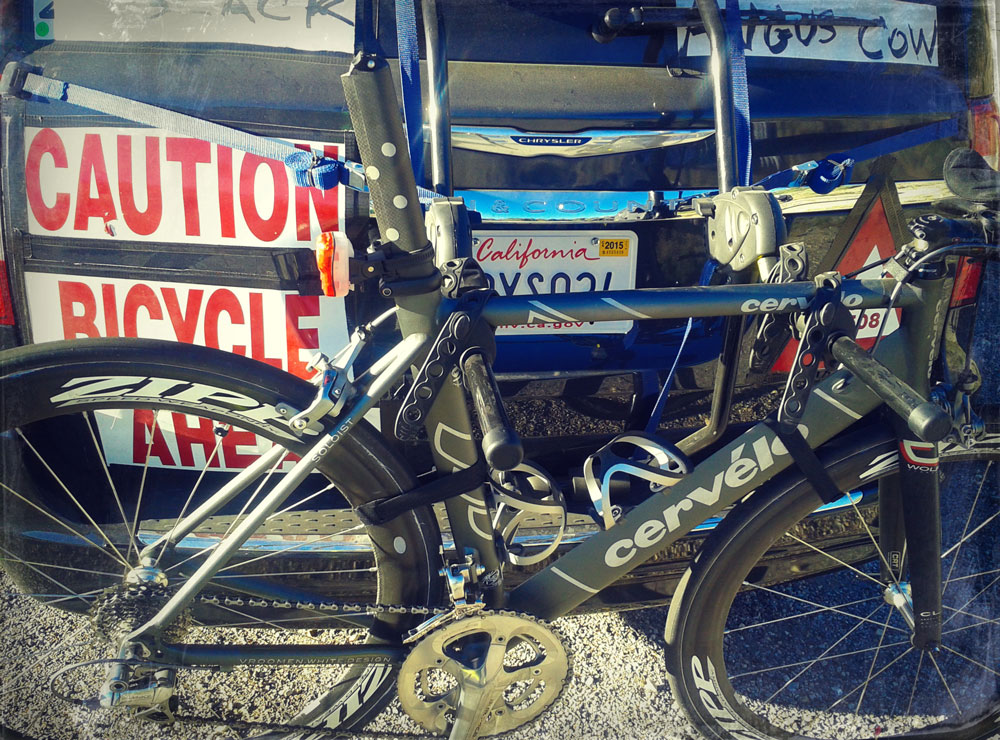
A bike without a seat dangling from the rack on the back of the support van,
double-dog-daring us to fix it.
*
Fallon seems impossibly far away as the sun climbs higher in the sky and the temperature rises. Keith becomes visibly fatigued and Scott isn’t sure he’s recovered yet. We stop the van every five, then three, then two, miles for Keith whose resolve wears thin on that awful stretch of desolate chip and seal road through the salt flats.
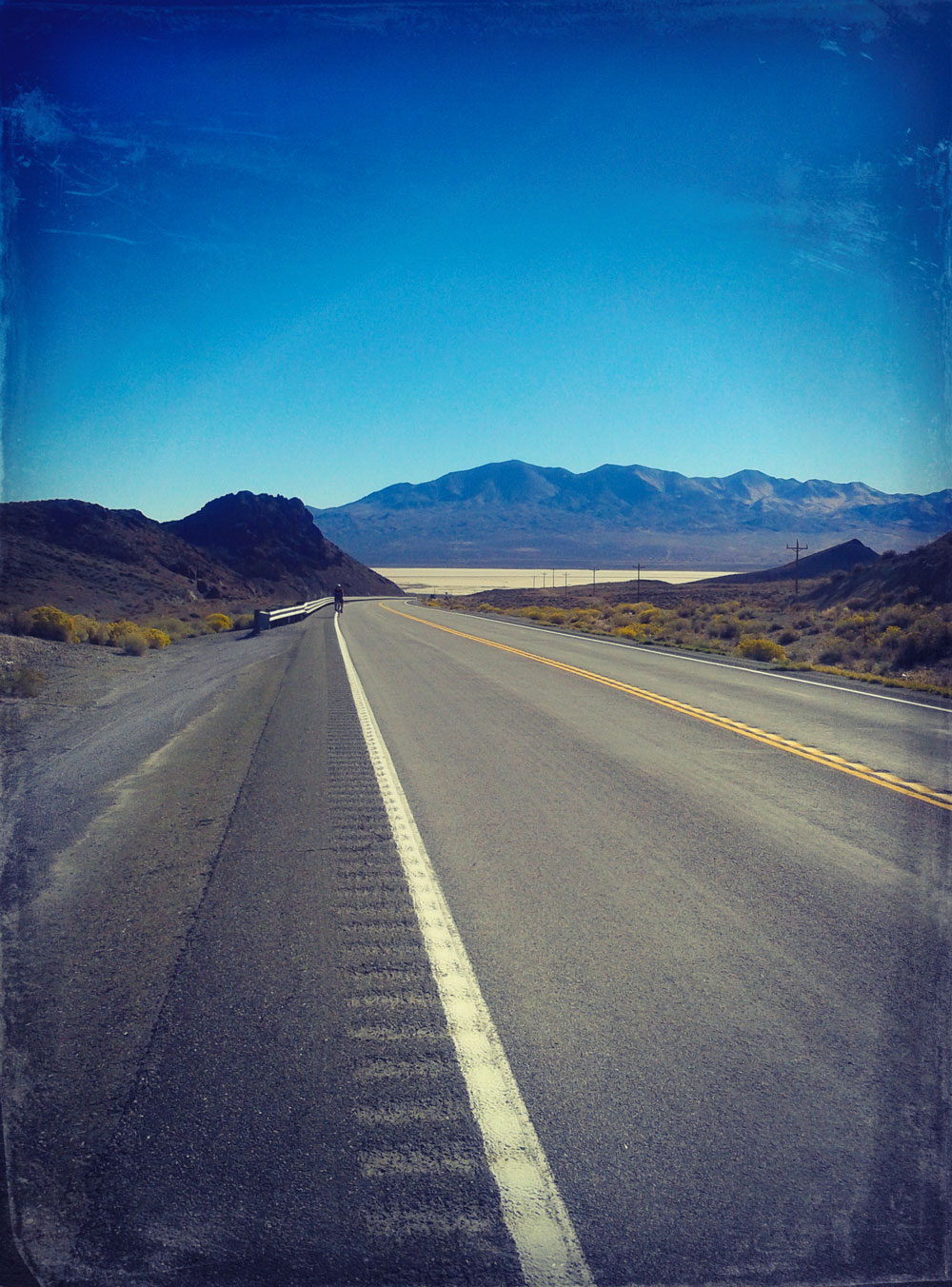
Nevada's wide vistas as we ride west, back to the finish line in Reno.
Despite the heat, the rough road and despite having ridden across the state of Nevada, we get to the next exchange point in Fallon and Scott’s bike once again becomes his own. He begins his final leg between Fallon and Silver Springs and rides with strength and confidence through the hot, windy expanses which stretch to Silver Springs (and the flashing warning signs to keep alert for wild horses.)
As the race approaches its final miles, Keith is on Scott’s bike for the final leg: up Six Mile Canyon to Virginia City to Geiger Summit, to Reno and to the finish line at the Atlantis Casino. The finish is so close I can nearly smell it in the breeze that wafts through the cottonwood trees of Six-Mile Canyon.
Keith will say Scott’s wheels make a strange sound which echo from the canyon walls, producing the sound of human voices, whispering. He remembered the ghost stories surrounding Virginia City and, along with the heat and fatigue, he scanned the canyon rim for bodies to accompany those voices. Of course, he finds nothing, which was “rather spooky.”
Five miles from the finish line, the back tire of our only usable bike goes flat and I wonder how much longer the elements will keep us out here, on the road. Instead of repairing the flat, Keith and Scott simply remove Scott’s back wheel and slip Keith’s in its place and the bike becomes a kind of “Frankenstein”, a miss-mash of rider and components.
Then, Keith resumes his leg to the finish line.
In the final miles, I wonder: What is it? Where is it? What have we gained? Why do we keep going?
I’m so deliriously tired I’m nearly blind I laugh into the silence of the car. I say I will karate-chop the flies that settle in our cockpit, the desert a backdrop to this insanity, this levity which tells me what is another eternity of miles? As long as there are ginger ales and cokes and gatorades and black licorice…? What is an unpublished manuscript? What of those uncomfortable hours of training leading up to a race that never happens? What of those things the distance hides and reveals in the paradox that an endurance athlete comes to know: that the miles are as much of a running away as they are a running towards?
*
In the desert, I decide we have found a truer understanding of “distance”, with the inner and outer, and the lines that narrow between the two. Within the emptiness of its silence spread out across the vistas, seeping into the blue mountains in the distance, there is something. It’s a place you see yourself writ large, the things you couldn’t quite mend, the people or the time you’ve lost.
Challenges flicker in the shadows of headlights, of the sun and your imprint on the earth moving slowly across these vast spaces of Nevada’s rediscovered lands. The darkness and the unknown... and the fear that you might not make it.
Perhaps that is what these events—in the very end—offer. It is a small and silly and constructed reassurance of a race that, in fact, you will.
The End
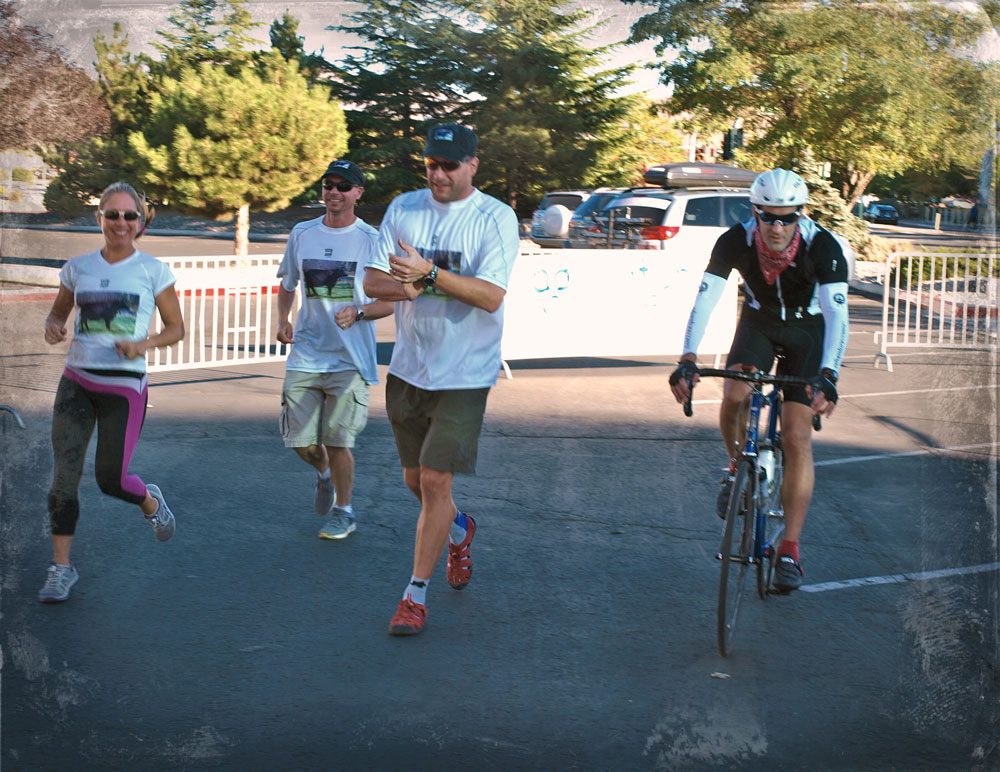
Team Black Angus Cow cross the finish line at the Atlantis Casino in Reno. (The author is on the left.)
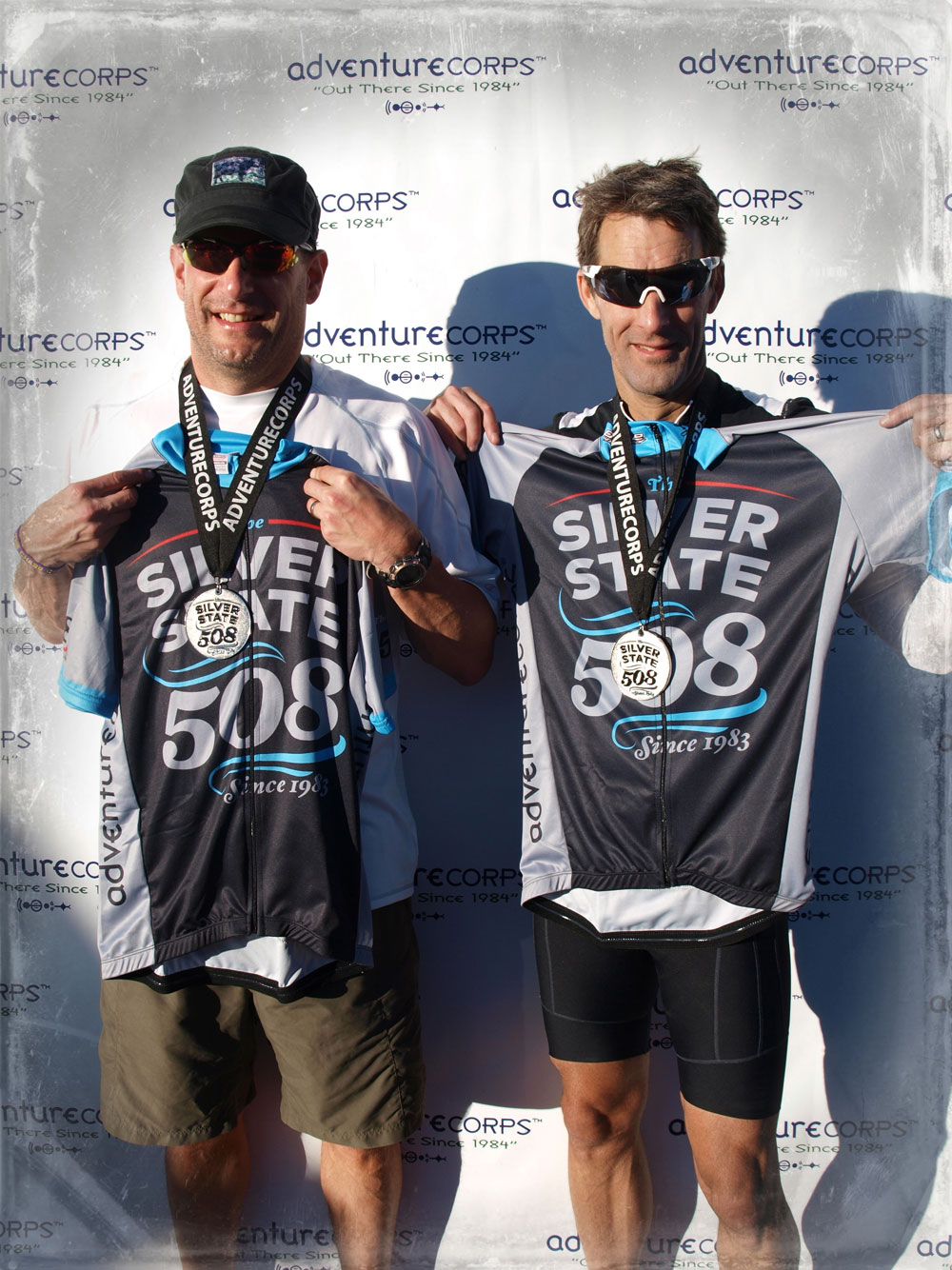
Scott Kollins and Keith Weitz of team Black Angus Cow after completing the inaugural Silver State 508.